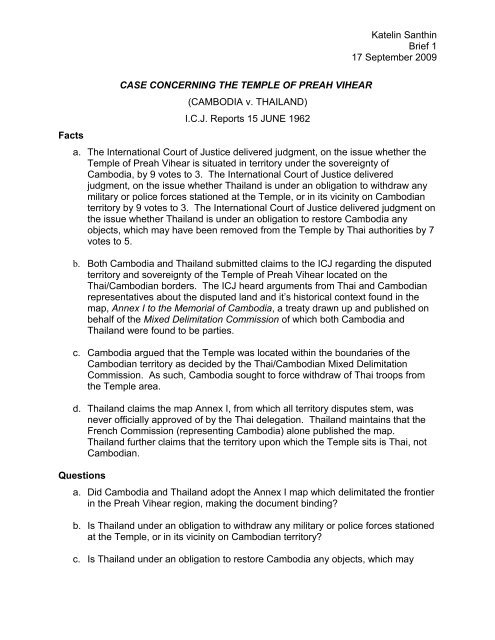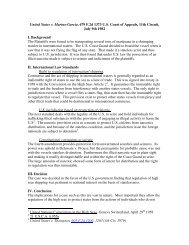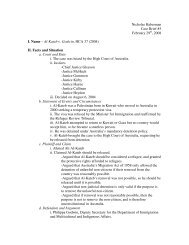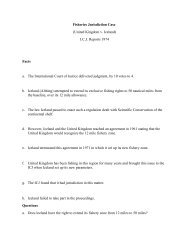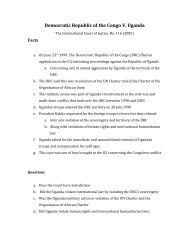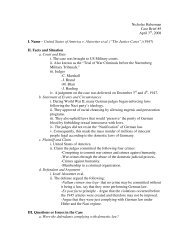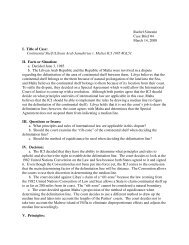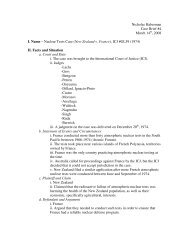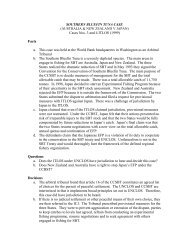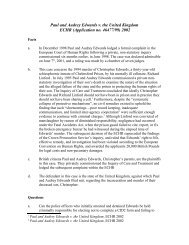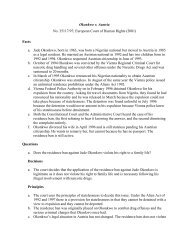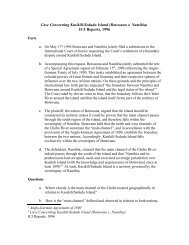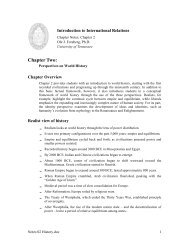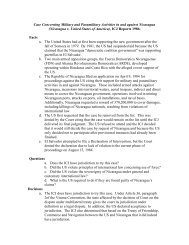CASE CONCERNING THE TEMPLE OF PREAH VIHEAR - Courses
CASE CONCERNING THE TEMPLE OF PREAH VIHEAR - Courses
CASE CONCERNING THE TEMPLE OF PREAH VIHEAR - Courses
You also want an ePaper? Increase the reach of your titles
YUMPU automatically turns print PDFs into web optimized ePapers that Google loves.
Santhin 2have been removed from the Temple by Thai authorities?Decisionsa. The Court found that the delimitation line determined by the Franco-SiameseMixed Commission is the official border between Cambodia and Thialand. Thisindicated to the Court that both Cambodia and Thailand adopted the Annex Imap which delimitated the frontier in the region of the Temple of Preah Vihear.As such, Annex I is binding and Thailand must respect the borders establishedby the document. The Court reasons that Thailand had every opportunity tocontest the borders established by Annex I, but did not, even with ampleknowledge that the Temple would be included within the Cambodian border.b. The Court held that because Thailand is party to the territorial agreementbetween Cambodia and Thailand, it must withdraw troops from the Temple ofPreah Vihear, as it is not Thai property. Because the Temple was clearlylabeled on the Annex I map of the territory in question, and because it clearly sitswithin Cambodia territory, Thailand could not make the defense that she hadauthority to station guards at this location. Further, the Court finds Thailand’sdefense insufficient on all accounts because Thai authorities did not raisequestions about Annex I, and it did not contest the location and ownership of theTemple until 1958, a full 50 years after the Court established that Thailandconsented to the agreement with Cambodian and French authorities.PrinciplesThe Court rejects Thailand’s claim that Annex I was used only for cartographicalreasons because no other maps were available. The use of Annex I, whichclearly marked Temple Preah Vihear as the property of Cambodia, could havebeen contested for it’s accuracy with Cambodian representatives. As Thailandnever took such necessary steps to rectify the cartographical errors, the claim isunfounded.a. The international law elements of the case are territorial sovereignty, and thepower of treaties.b. The Court weighed heavily the historical context of the creation of Annex I inmaking its judgment. It is clear that the Court found it important to first clarify thefrontier lines between Cambodia and Thailand before deciding the issue ofsovereignty. Because one could not be correctly judged without the other, theprinciples of subject-matter jurisdiction, temporal jurisdiction and territorialjurisdiction are all important in this case.c. The power of treaties held Thailand accountable for the border dispute andallowed Cambodia to expel Thai forces from the Temple.ConclusionsThe Court’s ruling in this case settled the border dispute between Cambodia and
Santhin 2Thailand over the location of Temple Preah Vihear. Further, the ruling put afreeze on Thailand’s use of troops in the Cambodian territory as well asproscribed that Thailand return to Cambodia any items taken from the Templeafter the map Annex I was consented upon by both nations.BibliographySubmittedCase Concerning the Temple of Preah Vihear, Judgment, I.C.J. Reports 1962Katelin Santhin, 17 September 2009


